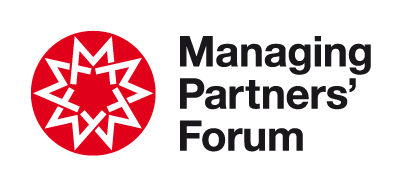December’s MTT meeting, hosted by Allen & Overy, was a presentation by organisational communications expert Andrew Lambert with written contributions from Keith Hardie, Bryan Cave Leighton Paisner’s director of innovation, marketing and business development, who has a long career in corporate communications in multiple sectors and industries.
Lambert defined four key features of organisational communication: instruction, information, consultation and participation. The first two are practical – letting people know what you want from them and providing relevant information – while the latter two are two-way channels. A single meeting might include all four features.
Hardie highlighted the existential threats that professional services face: new market entrants, technology, data analytics and commoditisation are driving change and firms need to develop the capability to adapt to an evolving market. Organisational change depends on effective communication, because it requires everyone to feel engaged and committed, understand and agree on the challenges and appreciate where their firm needs to focus.
Lambert presented a brief history of corporate communication which evolved as organisational culture and stakeholder engagement became critical success factors. Although the corporate communication function first emerged in the 1980s, it was not until the early 2000s that online and mobile technology facilitated integrated communication, strategic messaging and change communications. In the past decade, rapid messaging via social media platforms and the impact of viral communications and networking, fake comms, influencers, peer review and the millennial work ethos shifted the focus from communication to culture; from (trying to) control their corporate messaging to influencing and engaging internal and external stakeholders in their brand and its strategy going forward.
Communication as corporate glue
Communication is often described as the glue holding organisations together. The challenge is to shift to a communication strategy which reflects the new world order where influencing and engagement are more important than control. Lambert set out some of the elements of this change:
Information push → Information pull
Product push → Customer delight, retention
Submissive employees → Intelligent internal customers
Command/control bosses → Credible, inspiring leaders, who exist to support
Rigid structures, processes → Intangible corporate glue
Re-inventing the wheel, corporate amnesia → Learning organisation
Communication managers → Managers as communicators
Managing corporate communication is about matching the message to the process. This means deciding when you simply need to raise awareness, and when you need engagement, understanding, support and involvement. Professional services have the additional challenge of the partnership structure creating a communications gap.
Hardie believes that there are tough questions for professional services in terms of developing the right environment to attract talent and expertise outside their core offerings: for example, they will need technologists, data scientists and marketing and branding experts.
A holistic communication strategy – and a double-edged sword
The solution is a holistic communication strategy. And this means making a plan – and a developing a methodology for delivering communication to all audiences in a coordinated way. Lambert presented an overarching model with the core brand at the centre communicating consistent messages to a segmented audience using the appropriate format and media for each group. A second model is applied to match process and platform/media to the communication objective, which ranges from raising awareness (emails, newsletters, websites etc) through understanding (team meetings, roadshows, online chat), support (consultation, debate, feedback) and involvement (decision-making, problem solving) to commitment.
Social media drives convergence, adding two-way interaction throughout the corporate communication model. Lambert describes social media as a double-edged sword: on one hand it speeds up the organisational clock, provides metrics for measuring the impact and effectiveness of messaging, integrates different activities and fosters innovation. The downside is distraction, dependence, bullying, hacking, misinformation and malevolent dysfunctional targeting. Effective communication therefore requires the management team to be on top of technological developments and engage with their staff online.
Trust and responsibility
Communication management is a subset of managing relationships, observed Lambert, and the biggest challenge to internal comms is that everyone is focused on their own agenda and career. Overcoming this means focusing on team, group and organisational dynamics and behaviours.
Relationships are based on trust, which is the key to relationship management, inclusivity and co-creation and collaboration and organisational effectiveness.
Digital transformation provides useful metrics for organisations to measure their processes, and their employees but they also facilitate revelations and review by external bodies.
In today’s rapid online environment, there is no hiding place for misbehaviour within organisations. Lambert highlighted news stories including former Uber CEO Travis Kalanick’s departure following revelations about the company’s toxic culture and current cases relating to bullying and sexual misconduct in professional services firms. Effective communication is impossible without addressing cultural and behavioural issues which undermine trust in the organisation.
Everyone in the organisation needs to understand their responsibility for its culture: leaders, managers, team leaders, central functions including communications as well as employees and contractors, including people who work remotely. While firms can monitor activities, culture is about shared discipline rather than enforcing rules. So, it makes sense for organisations to involve their staff in developing social media polices, for example.
Inspiring and engaging leaders are role models for the organisation. Organisations need to consider the extent to which the top team is working together – professional services partnerships have a broader model, but they still need to avoid silos and microcultures.
A communication culture
Another framework for communication capability reflected the corporate ‘iceberg’ model where behaviours (above the surface) reflect organisational values and beliefs (below the water line).
- Foundations – mission, values
- People – Selection, assessment and development; reward and promotion; role modelling at the top
- Policies and processes – freedoms within (agreed) boundaries; fit-for-purpose standards (i.e. why are we doing that?)
- Learning – especially from mistakes
- Stories – what gets celebrated (to create and embed a positive culture); employees as ambassadors
These principles need to be delivered by integrated corporate functions with aligned communication practices. Technology supports relationships with real-time communication flows; networking and collaboration platforms; triangulated measurement – i.e. using data from different sources. Personalisation is more complex. When it is well-designed it encourages engagement, but the danger is using personalisation for control – i.e. too much personalisation or measurement feels intrusive and can undermine employee/customer trust. But recognition is critical as it underpins employee engagement.
Hardie added that in law firms in particular the internal comms function is often seen as the centre of corporate messaging and firmwide meetings, but it has to go further. Importantly, leaders have to know what good looks like. They recognise the importance of a strong communications culture, but do they know what steps they have to take to get there?
Lambert’s starting point is a checklist of ‘absolute essentials’:
- Honesty – truth-telling, transparency, prompt and full admission of mistakes, no blame
- Language – clear, simple, concise
- Listen
- Equity – fairness, mutuality, no bias
- Empathy – demonstrate understanding and care
- Accountability – no buck-passing
- Confidence – disarm fear, inspire creativity and positivity, become an organisation where people are willing to share ideas
The discussion was opened up to delegates from different professional services firms. Topics raised included maintaining a communication culture during international expansion, post-merger cultural integration, and big picture messaging.
Joanna Goodman

